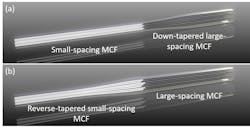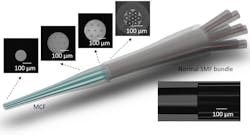New technique could boost next-gen optical-based networks
Demand for increased capacity in optical communication networks is growing. Optical fiber—specifically, multicore fiber (MCF)—is a strong candidate to meet the growing need, given some key advantages. MCFs, optical fibers containing more than one fiber core, feature high-density multichannel architecture inside a single casing. This reduces production costs per channel, takes up less space than conventional single-core single-mode fibers, offers high transmission capacity, and eliminates cross-sensitivity.
Armed with these advantages, MCF systems could potentially enhance applications such as space-division multiplexing telecommunication, data-center connection, inter-chip communications, next-generation fiber amplifiers, optical shape sensing, fiber-optic gyro, and quantum technologies, etc.
MCF splicing is necessary to advance such development, says Li-Min Xiao, a professor in the Advanced Fiber Devices and Systems Group and the Yiwu Research Institute, both at Fudan University in China, but right now, MCF splicing is far from a mature technology.
“The fan-in and fan-out (FIFO) device of MCF is the key component to connect it with the single-core SMFs, which poses an intrinsic integration challenge for low-crosstalk coupling due to the densely packed channels of MCF,” Xiao says.
Among the challenges: creating a general fusion splicing structure between dissimilar MCFs, and fabricating FIFO devices with overall performance in terms of coupling efficiency, crosstalk, return loss, and device compactness.
“To build up a monolithic MCF system, being able to splice two different MCFs with different mismatched spacings, also called inter-core pitches, has become a common problem,” Xiao says. “Also, the rigid (unchangeable) interface of MCF in previous works makes it challenging to obtain the good overall performance of the FIFO device without using the bridge element.”
Coupling light for multiple signal channels into several different cores in the multi-fiber and splicing them is also challenging, because it’s been difficult to match the mode field diameter of individual cores while also avoiding crosstalk of each at the splicing point. And it can be difficult, too, to manage outputs from those multiple cores—they must be carefully aligned to work properly. Increasing the transmission capacity per fiber will be key for next-generation data and telecommunications.
Now, a new technique clears these hurdles.
Fusion splicing, fiber tapering
“Low-loss fiber fusion splicing in MCFs is the basic supporting technique for fiber device construction and system connection,” Xiao says. He and several colleagues developed the new method that achieves such splicing between dissimilar MCFs via reverse-tapering and down-tapering schemes.
Tapering optical fiber involves heating the fiber to stretch and reshape it. This makes the fiber thinner and increases its size by a few millimeters or even centimeters. The fiber core gets thinner by the same factor as the total fiber, Xiao says, and the core-to-core spacing becomes smaller via the down-tapering process. With reverse-tapering, the fiber can be compressed while heated. This makes the core-to-core spacing and the core itself larger (see Fig. 1).
Two crucial values determine the quality of the MCF splice—the splice loss of each core and the crosstalk between cores. Down-tapering could diminish splicing quality and increase crosstalk. Reverse-tapering alleviates those issues, making it a particularly attractive method.
“The reverse-tapering process can make the matching of core-to-core spacing between two dissimilar MCFs to align each core precisely,” he says, adding that more importantly, matching the spacing and the mode size demonstrates low-loss and low-crosstalk fusion splice between two MCFs that are spacing-mismatched.
Both tapering processes, in combination, can be exploited to tailor the spacing and modify the modal property of MCFs and SMF bundles (see Fig. 2).“The reverse-tapering process can construct a spacing-tailored interface between the MCF and the normal SMF bundle for the first time,” Xiao says. “The tapered normal SMF bundle cannot generally be used to connect with the MCF because the tapering ratio should be large to reduce the core-to-core spacing between SMFs to match with that of MCF, which increase the mode field mismatching and the crosstalk.”
In their splicing work, the researchers demonstrated the low-loss at 0.18±0.10 dB and low-crosstalk of -68±3 dB fusion splice between two MCFs with a spacing difference of up to 26 μm. The tapering schemes can also splice between MCFs with slightly different spacing. Xiao says no methods have been reported before now to splice spacing-mismatched MCFs.
With the team’s FIFO device work, the fabricated FIFO device for the small-core MCF with narrow core-to-core spacing of 35 μm features a low average coupling loss (~0.6 dB), very low crosstalk (< -65 dB), and a return loss (< -60 dB) without using any bridge elements. The researchers say the “remarkably low” crosstalk is about 20 dB lower than using special bridge fibers for the same type of MCF.
Fabrication and manufacturing
“This unique fusion splicing and tapering technique can significantly facilitate MCF device fabrication and boost various MCF applications. It will provide the freedom for MCF design in terms of inter-core pitches and fiber size,” Xiao says. “People can optimize the fiber parameters, focusing on their specific applications (i.e., the chip connection or MCF amplifiers), and they will not worry about the connection problem with other MCFs in the system.”
Traditionally, optimizing MCFs for specific applications requires varied parameters because there have been no universal standards for their design. This has hampered the efforts to develop the low-loss connecting of two different MCFs; specifically, erbium-doped active MCFs, which are a basic building block for fiber-optic amplifiers used in broadband optical networks, and passive transmission MCFs, which are optical fibers that passively transmit light.
Even when two MCFs share the core number and position pattern, the core size and spacing could be different because of varied designs or fabrication tolerance. The new splicing and tapering technique overcome this because it meets the demands of low-tolerance, high-precision fabrication, Xiao says, and it can expand the freedom of fiber-optic design.
RELATED READING
1. W. Ji et al., J. Light. Technol. (2022); doi:10.1109/jlt.2022.3177622.
2. W. Ji et al., Opt. Lett., 46, 6112-6115 (2021).
About the Author
Justine Murphy
Multimedia Director, Digital Infrastructure
Justine Murphy is the multimedia director for Endeavor Business Media's Digital Infrastructure Group. She is a multiple award-winning writer and editor with more 20 years of experience in newspaper publishing as well as public relations, marketing, and communications. For nearly 10 years, she has covered all facets of the optics and photonics industry as an editor, writer, web news anchor, and podcast host for an internationally reaching magazine publishing company. Her work has earned accolades from the New England Press Association as well as the SIIA/Jesse H. Neal Awards. She received a B.A. from the Massachusetts College of Liberal Arts.


